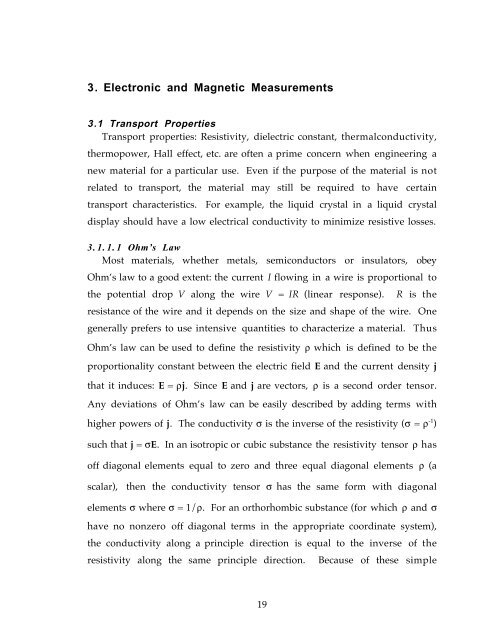MAGNETISM ELECTRON TRANSPORT MAGNETORESISTIVE LANTHANUM CALCIUM MANGANITE
MAGNETISM ELECTRON TRANSPORT MAGNETORESISTIVE LANTHANUM CALCIUM MANGANITE
MAGNETISM ELECTRON TRANSPORT MAGNETORESISTIVE LANTHANUM CALCIUM MANGANITE
Create successful ePaper yourself
Turn your PDF publications into a flip-book with our unique Google optimized e-Paper software.
3. Electronic and Magnetic Measurements<br />
3.1 Transport Properties<br />
Transport properties: Resistivity, dielectric constant, thermalconductivity,<br />
thermopower, Hall effect, etc. are often a prime concern when engineering a<br />
new material for a particular use. Even if the purpose of the material is not<br />
related to transport, the material may still be required to have certain<br />
transport characteristics. For example, the liquid crystal in a liquid crystal<br />
display should have a low electrical conductivity to minimize resistive losses.<br />
3. 1. 1. 1 Ohm’s Law<br />
Most materials, whether metals, semiconductors or insulators, obey<br />
OhmÕs law to a good extent: the current I flowing in a wire is proportional to<br />
the potential drop V along the wire V = IR (linear response). R is the<br />
resistance of the wire and it depends on the size and shape of the wire. One<br />
generally prefers to use intensive quantities to characterize a material. Thus<br />
OhmÕs law can be used to define the resistivity ρ which is defined to be the<br />
proportionality constant between the electric field E and the current density j<br />
that it induces: E = ρj. Since E and j are vectors, ρ is a second order tensor.<br />
Any deviations of OhmÕs law can be easily described by adding terms with<br />
higher powers of j. The conductivity σ is the inverse of the resistivity (σ = ρ -1 )<br />
such that j = σE. In an isotropic or cubic substance the resistivity tensor ρ has<br />
off diagonal elements equal to zero and three equal diagonal elements ρ (a<br />
scalar), then the conductivity tensor σ has the same form with diagonal<br />
elements σ where σ = 1/ρ. For an orthorhombic substance (for which ρ and σ<br />
have no nonzero off diagonal terms in the appropriate coordinate system),<br />
the conductivity along a principle direction is equal to the inverse of the<br />
resistivity along the same principle direction. Because of these simple<br />
19
















